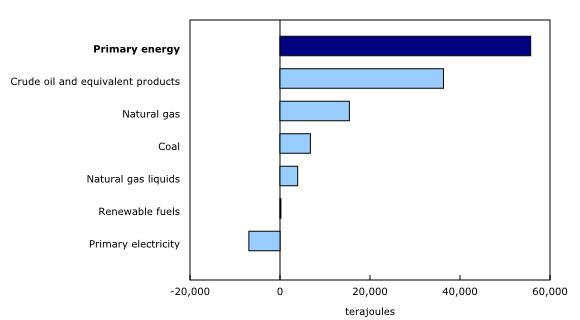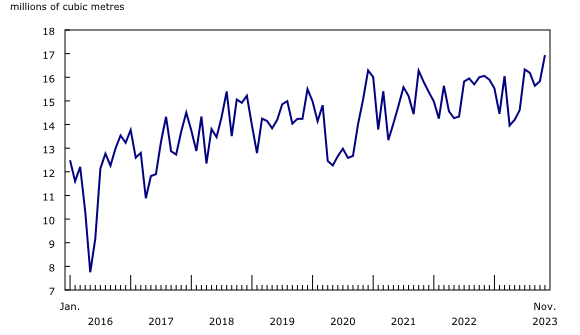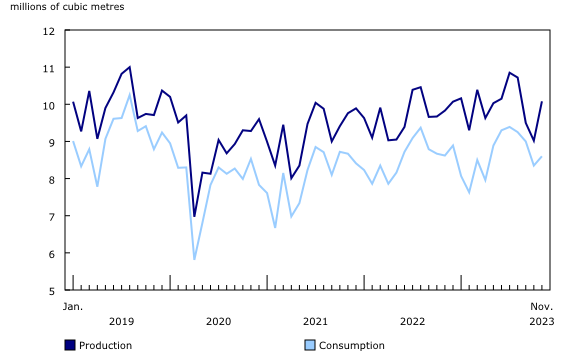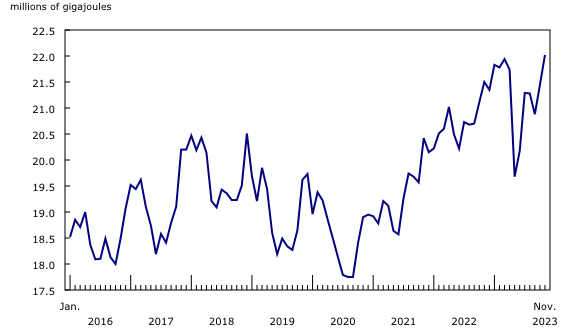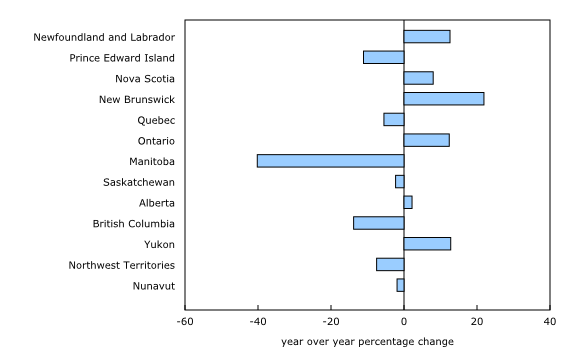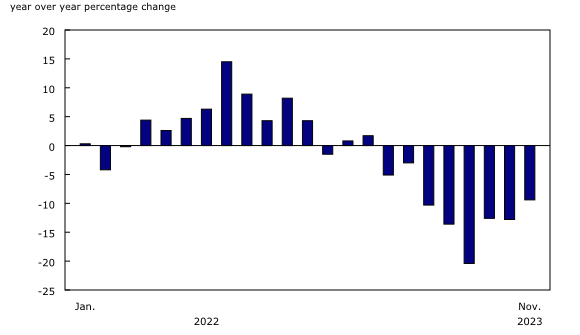Energy statistics, November 2023
Released: 2024-02-01
Primary energy production increased 2.9% in November, with crude oil and equivalent products (+3.8%) leading the increase. Secondary energy production was down 1.0%, led by refined petroleum products (-2.3%).
For more information on energy in Canada, including production, consumption, international trade, and much more, please visit the Canadian Centre for Energy Information portal and follow #energynews on social media.
Check out the new StatsCAN Plus article on electric vehicles and the electricity infrastructure that supports them!
Oil sands drive Canadian crude production to new series high
Production of crude oil and equivalent products reached a record high in November, climbing 3.8% year over year to 25.4 million cubic metres. This was the largest year-over-year increase since January 2023, as scheduled maintenance in oil sands facilities was completed, contributing to increased efficiency in operations.
Oil sands extraction led the overall gain in production, up 5.5% to 16.9 million cubic metres, the highest volume since the start of this series in 2016. Production of synthetic crude (+2.7%) and crude bitumen (+7.4%) both increased in November.
Production of finished petroleum products increases in November
Production of finished petroleum products climbed 2.5% year over year to 10.1 million cubic metres in November. Finished motor gasoline (+5.6%) and distillate fuel oil (+4.7%) drove the overall increase.
Consumption of finished petroleum products was relatively flat (-0.3%) in November, totalling 8.6 million cubic metres. Exports of finished petroleum products fell 2.7% to 1.2 million cubic metres, while imports rose 1.6% to 0.8 million cubic metres.
Production and exports of natural gas climb in November
In November, production of marketable natural gas rose 2.4% year over year to 660.5 million gigajoules. The highest daily production of natural gas since this series began in 2016 was recorded in November, with an average of 22.0 million gigajoules each day.
Total deliveries of natural gas to Canadian consumers (+5.0%) rose for the 10th consecutive month. The industrial sector (+7.4%) was responsible for the increase, with deliveries in Ontario (+31.7%) and Alberta (+3.2%) contributing the most to the rise in November.
Dry conditions continue to affect electricity generation and trade in November
Total electricity generated in Canada declined 1.3% year over year to 52.9 million megawatt-hours (MWh) in November. Hydroelectric generation was the main contributor, down 9.4% to 29.6 million MWh. Extended dry conditions have reduced hydroelectric generation across Canada, with Manitoba (-41.4%) and British Columbia (-18.6%) being affected the most.
Electricity generated from combustible sources climbed 12.0% to 11.5 million MWh in November, primarily due to a doubling (+99.6%) of Ontario volumes, compensating for decreased hydroelectric generation. Nuclear generation rose 11.8% to 6.9 million MWh, as more capacity was online following maintenance and refurbishments at nuclear generating stations last year.
Consumption of electricity rose 2.5% in November due mainly to a 5.0% increase in Quebec, coinciding with a year-over-year increase in heating degree days in that province.
Imports of electricity from the United States increased sharply by 106.6% to 2.2 million MWh in November, as Manitoba and British Columbia purchased electricity to compensate for reduced hydroelectric generation.
Exports of electricity to the United States were down 20.3% in November compared with the same month one year ago. The main driver was Quebec (-41.7%), which has reduced exports to conserve its hydroelectric generation reservoirs amid dry conditions. Manitoba (-64.4%) and British Columbia (-36.2%) also contributed to the drop. Conversely, higher exports from New Brunswick (+101.2%) and Ontario (+12.9%) partially offset the overall decrease.
Did you know we have a mobile app?
Get timely access to data right at your fingertips by downloading the StatsCAN app, available for free on the App Store and on Google Play.
Note to readers
The survey programs that support the "Energy statistics" release include:
- Crude oil and natural gas (survey number 2198; tables 25-10-0036-01, 25-10-0055-01 and 25-10-0063-01). Data from October 2023 have been revised.
- Energy transportation and storage (survey number 5300, tables 25-10-0075-01 and 25-10-0077-01).
- Natural gas transmission, storage and distribution (survey numbers 2149, 5210 and 5215; tables 25-10-0057-01, 25-10-0058-01 and 25-10-0059-01).
- Refined petroleum products (survey number 2150, table 25-10-0081-01).
- Renewable fuel plant statistics (survey number 5294, table 25-10-0082-01).
- Electric power statistics (survey number 2151, tables 25-10-0015-01 and 25-10-0016-01).
- Coal and coke statistics (survey numbers 2147 and 2003, tables 25-10-0045-01 and 25-10-0046-01).
The consolidated energy statistics table (25-10-0079-01) presents monthly data on primary and secondary energy by fuel type (crude oil, natural gas, electricity, coal, etc.) in terajoules and supply and demand characteristics (production, exports, imports, etc.) for Canada. The table uses data from a variety of survey and administrative sources. For more information, please consult the Consolidated Energy Statistics Table: User Guide.
Data are subject to revisions. Energy data and other supporting data used in the text are revised on an ongoing basis for each month of the current year to reflect new information provided by respondents and updates to administrative data. Historical revisions are also performed periodically.
Definitions, data sources and methods for each survey program are available under the respective survey number.
The Energy Statistics Program relies on data collected from respondents and administrative sources.
Data in this release are not seasonally adjusted.
Occasionally, data from Environment and Climate Change Canada are referenced by the Energy Statistics Program using Cooling Degree Days (CDDs) or Heating Degree Days (HDDs) as a measure of temperature. CDDs reflect the relationship between outdoor temperatures and the need to cool indoors to maintain room temperature. As temperatures outside rise, the number of CDDs increases. HDDs are the opposite and reflect the need to heat indoors to maintain room temperature. As temperatures outside fall, the number of HDDs increases.
Contact information
For more information, or to enquire about the concepts, methods or data quality of this release, contact us (toll-free 1-800-263-1136; 514-283-8300; infostats@statcan.gc.ca) or Media Relations (statcan.mediahotline-ligneinfomedias.statcan@statcan.gc.ca).
- Date modified:



